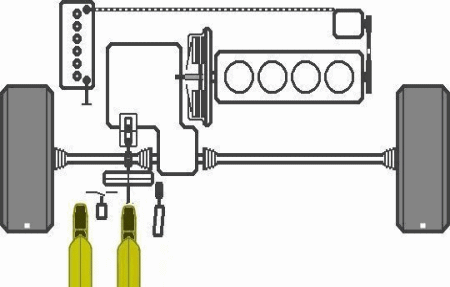Recuperation 2

We typically answer more questions in our book chapters, but this topic may leave more unanswered than originally asked. You just have a fixed opinion about recuperation and that needs to
be shaken first.
Recuperation is therefore the return of mechanical energy as electrical energy into a battery, thermal left out. And that's where it starts, because does it have to come entirely from this battery?
If this were, for example, the normal 12V battery of a combustion engine, then it would have contributed absolutely nothing to the forward movement.
Is recuperation even possible and reasonable with a pure combustion engine? At least in connection with a start-stop system you can confidently say yes. Imagine that it is used intensively,
then every possibility of recharging without involving the engine must be used, otherwise there will be nothing left of the savings.
But how does recuperation work in a pure combustion engine with or without start-stop? Already when you decelerate? Here we want to make the first restriction of the term. Accordingly,
recuperation would be the return of mechanical energy to a battery, but no other system is likely to be effective.
For the combustion engine, this would mean that it could run, and perhaps its ignition too, but the fuel injection would have to be switched off, as is common practice today. Then it hinders
recuperation, but does not prevent it. We therefore come to the surprising conclusion that every car that is driving and you take your foot off the accelerator recuperates.
However, one restriction must be made, namely that the clutch remains unactuated and the engine has significantly more than idle speed, i.e. it is in overrun mode. An intelligent circuit that
prefers to recharge the battery under these circumstances would be even more energy-saving.
This could also be the case when braking. However, any braking process would harm such recuperation because it not only shortens the period but also dissipates part of the kinetic energy
into heat. This may have been a possible approach to more effective recuperation in electric cars.
If the desired braking effect, expressed by a certain pressure on the pedal, remains below a g value of, say, 0.2 g (lately even 0.3), then the actual brake is not even activated. The engine
control unit, together with that for the brakes, exclusively uses the boost of the electric motor for recuperation.
If this is done well, the current drawn could even vary depending on pedal pressure and thus the braking effect of the electric motor could be regulated by drawing energy. However, the
particular difficulty of this system is founded in the task of switching back to the normal brake without the driver noticing when he increases pedal pressure.
It would actually be desirable if the electric motor remained connected even when braking hard, but that is probably too complicated and could actually increase the braking distance. So when
you brake harder it is decoupled or the brake continues to work on its own. There are also manufacturers, such as the already mentioned Tesla company, who do not use recuperation when
braking.
| Light to moderate braking is usually associated with releasing the
accelerator. |
This brings us to the second variant of recuperation, namely the during reducing the position of the gas or current pedal. It is important that the engine of a purely electric car and the generator
of a combustion engine remain connected to the drive system. If, for example, here is separated by an automatic clutch or a clutch operated by the driver, this is called 'sailing'.
This no longer results in recuperation, but the energy gain can be even greater if you drive forward-looking. Because here too, kinetic energy is reused. Recuperation would result in a stronger
braking effect and you would then have to start the engine again, so to speak, in order to continue driving.
So if you use sailing skillfully, you may be able to cover the entire distance without additional engine power. In principle, sailing is possible with any vehicle, whether it is a combustion engine or
an electric car or both. Of course, it is optimal if the engine switches off completely, which of course is not possible with a conventional combustion engine.
|